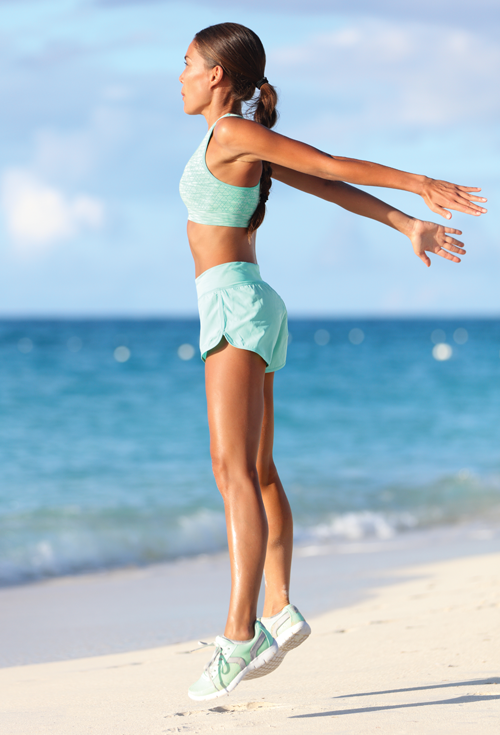By Juliane Morris
In the summer time, a beach or a park is a great place to exercise
A healthy body’s ability to continually find balance and stability as a moving mass is truly a remarkable feat. Think about when you may have accidentally tripped on an uprooted crack in a sidewalk, or up a misjudged stairwell step. Those times when you nearly fell down but otherwise caught yourself, or your body caught itself for you. You didn’t even think about it, until afterwards. It’s tough not to appreciate our body’s astonishing and automatic standard of finding continual balance and stability. Think about when your body doesn’t recover from a trip. You may have been flabbergasted and stunned that your body failed you.
Today we’re going to discuss some exercises that will help you enhance your body’s ability to balance and stabilize, with techniques to improve how your thighs support your overall health. Your upper legs act as trunks bringing intricate and flexible muscle groups together. It’s easy to think thigh appearance before thigh function, but your inner thigh muscles (adductors, made up of five different muscles) provide a lot of your body’s internal rotation, counterbalancing the external rotation that comes from outer thighs and your glutes. The inner thigh muscles stabilize the outward rotation of knees and pull legs toward the center of the body. Moreover, the adductors muscles attach to your pelvis and greatly affect your hip flexion and extension, and stabilize your core to provide stability and injury prevention for your knees, hips, and lower back.
Yes, your inner thighs are a surprisingly large part of your overall lower body strength. People used to try to spot train the inner thighs but exercise specialists have determined the value of a full body workout that engages the thighs. You’re not going to reshape your thighs with spot training but when you commit to work these muscles, you’ll enjoy an overall body benefit.
By incorporating the sorts of movements included in these three exercises in your body composition, including thighs, when you perform them as both strength and cardio training. These exercises aren’t going to bulk up your legs as often misunderstood about muscle work. Remember, long-term cardio and strength training increases your muscle mass, and since muscle mass takes more energy to maintain, you’ll burn more calories when resting (thus often increasing your basal metabolic rate).
You can do these just about anywhere you might be exercising or active. In the summertime, a beach or park is a great location to do these on your own or with a workout buddy.
Squats
Squats are a great part of an active and fit life.
- Stand with feet hip-distance apart and toes turned slightly out.
- Sit back, keeping weight on heels and stopping hips just above knee line, arms extended forward, hands held comfortably together or clasped.
- Hold for a count of 5. Return slowly and controlled to starting position.
- Repeat 10-12 times, completing two to four sets.

Pop Jump
Pop Jumps bring a burst of core stimulation and increase muscle strength and stability. Some people call these jumping squats. The explosive jumps work the thighs and also activate the glutes and arms.
- Stand with feet a little less than hip-distance apart and toes faced forward.
- Sit back, keeping weight on heels. Arms are at sides, bent at elbow 90 degrees, perpendicular to ground, hands facing one another.
- Jump quickly and powerfully upward while extending arms straight and backwards, being careful not to extend too far back.
- Return to strong and stable starting position. Repeat 10-12 times, completing two to four sets.

Plie Squat Calf Raises
Plie Squat Calf Raises are ballet-inspired and work the thighs, calves and glutes.
- Stand with feet hip-distance apart and toes turned slightly out.
- Sit back, keeping weight on heels and stopping hips just above knee line, arms extended forward, hands held comfortably together or clasped.
- Slowly and securely raise heels from ground, placing weight on ball of each foot, and being careful not to extend knee beyond foot toes distance to protect knee. Hold for 3-5 seconds, inhaling and exhaling deeply and keeping core tight with leg, arm and core muscles engaged.
- Return to strong and stable starting position. Repeat 6-8 times, completing two to four sets.



